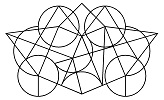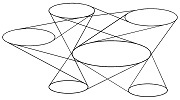


 |
 |
 |
The cause of corruption is power mongering by incompetent persons.
The Impracticality of Renewable Energy
Renewable energy as wind and solar power creates overwhelming clutter on the surface of the earth. Supposedly, the US get 12% of its electricity from windmills. A total fraud. Nameplate rating on the windmills is used for that number. Actual output of windmills is 20-30% of nameplate rating. It means the US is getting 2.4-3.6% of its energy from windmills. But considering the liars doing the rationalizing, the actual amount would be less. This is consistent with the fact that very few places have windmills. In the few places that have 15% electricity produced by windmills, the clutter is immense. There isn't enough space to double the amount to 30%. What happens when the whole country gets 15 or 30% of its electricity from windmills? There isn't enough space for that much clutter, considering that the low hanging fruit is already gone. It would be physically impossible to put up enough windmills for the US to get 30% of its electricity from windmills. And that is before electric autos exist, while the fakes claim they are going to produce 100% renewables to remove carbon dioxide from the air. This pertains to the windmills, not the transmission lines. Transmission lines are even more of a problem. Moderately long lines cost more than all other expenses combined in producing electricity. The cost is indicative of the clutter. The environmental damage would be indescribable in producing 30% of all electricity with windmills at this time without electric vehicles being added. Solar power is even more destructive to the environment than wind power. Not only does solar require a lot of surface area, but it would require even more lines than wind power, because no place has suitable climate but the southwest in the US. Roof solar will never be used significantly outside the south and west of the US, and only by persons who have more money than brains in those places. The basic problem with renewables is that the energy starts in a highly dilute form. Concentrating energy is not something that humans can do in a practical manner. There will not be a technological solution, because the mechanisms will always require a lot of metal. Electrons have to be surrounded by a lot of metal. The amount does not change with the technology. To reduce the metal on transmission lines is to increase the resistance. Resistance converts electrical energy into heat. Therefore, transmission lines are designed with a built-in loss of 20% for short lines and up to 50% for long lines. The result is so expensive that no one will invest in adequate transmission lines at this time, even where there is no renewable energy. There is a dangerously short supply of transmission lines in the US because of the large amount of space that needs to be covered, and no one has feasible answers. Renewables will multiply the problem without producing feasible answers. Wind and solar require back up systems which reduce the practicality. Back-up systems lose a large amount of energy in the process besides being extremely expensive to construct. And they increase the length of transmission lines required. Back-up systems are all petroleum based, and they must provide a very large percent of the energy. Solar only has high intensity sunshine for one fourth of the day when skies are clear. That means three times as much energy in the back-up system as in the solar system. Wind varies a lot, but 100% back-up potential is needed for when the wind quits. Wind can change faster than back-up systems can respond, which means anything over 15% wind energy in a system will cause blackouts or brownouts due to fluctuations. Ramping back-up systems up and down loses a lot of energy. Optimum conditions are required for reasonable efficiency. Responding to fluctuations moves conditions far from optimum levels. Combining inherent redundancy, overlap and inefficiencies in the back-up systems, there would be almost no gain in adding renewables to the process in many instances. To a large extent, renewables add little more to the backup systems than the clutter that ravages the environment. The dream world of solving these problems is not realistic. Storage of energy will never be a solution, because 60% will always be lost moving the energy into storage and another 60% will be lost moving it back out. There is no electrical transformation system that does not lose 60% or more of the energy beyond laboratory conditions which do not scale up. Recovering 40% of 40% is only 16%. Combined with the rest of the cost, recovering 16% is not practical. Batteries are for toys, not large scale industrial processes. They never will be practical as a utility scale storage system. Electrons in batteries have to be surrounded by a lot of chemical solution. The materials are not cheap including rare metals. Isolated examples of the wonders of renewables tell nothing, because they cannot be sustained, scaled up or broadened to other areas. Often partial systems will be portrayed as producing wonderful results without mentioning that someone else, somewhere else, made it possible by absorbing the negatives, such as a connection to larger transmission lines that can absorb fluctuations. More than anything, money is being poured into the process with no concept of cost-benefit relationships. These problems are insurmountable without electric vehicles. Adding electric vehicles to renewable systems multiplies the problems by a factor of many hundreds or thousands. Not only would the electrical generating systems be overwhelming, the lines would be increased in shipping the electricity to the point where the vehicles need it. But electric vehicles are not realistic with any source of energy, because at least 85% of the energy is lost before getting it to the vehicles. A natural gas electric generating turbine would deliver about 14.4% of its energy to an electric vehicle, where 25% would be converted into kinetic energy of motion, which is 14.4% x 25% = 3.6% recovered. A vehicle burning natural gas would convert 25-30% of the energy into motion. That's almost one tenth as much energy recovered by the electric vehicle as the petroleum vehicle. Why is the government paying consumers $7,500 to buy an electric vehicle? Batteries are not a Solution to Fluctuations Batteries being used to remove fluctuations with windmills is ignorance. Both windmills and batteries use dc voltage. dc voltage cannot be controlled through batteries. In electronics, capacitors are used as if they were fast-charging batteries. Capacitors are never used to control dc voltage. Instead, voltage regulators have to be used. They lose a lot of energy—usually 30-50% loss. So of course voltage regulators will not be used to level the voltage with windmills. Using batteries or capacitors to level dc voltage must waste at least as much potential as regulators. To create a leveling effect, there must be enough potential available to supply demands under low level conditions. This means the output must be set at the lowest expected level. With wind, the lowest possible level is zero. If a higher level is set, then a substitute source must be sometimes used. Even if batteries are only used for minor effects, they must be set at the minimum level (voltage or wattage) that is being regulated. That means higher levels are being wasted or not used. Another problem is that the set-level must be tailored for conditions, but there is no way of knowing in advance what the set-level should be. The net effect is that battery back-up for removing fluctuations with windmills will lose a minimum of 30-50% of potential, with another 30% lost in the inverter which creates ac voltage; and a substitute source is needed when wind conditions go below the set-level of the batteries. The lower the set-level, the more waste of potential there is; the higher the set-level, the more often a substitute source is needed when the wind goes down. In other words, adding batteries to the process results in more energy being wasted without eliminating the need for 100% back-up when the wind quits. Not to mention the fact that batteries are way to expensive for industrial level electricity, and always will be. There is a Wall at 15% Renewables Fifteen percent fluctuation is the maximum tolerable on electrical infrastructure. Circuit-breakers trip outside that range. Normally, fluctuations must be significantly less that 15%. The normal electrical infrastructure is absorbing fluctuations from renewable energy, when they are significantly less than 15%, while designers are attempting to reduce fluctuations. The amount of fluctuation from the renewable sources that can be tolerated depends upon what the feed is going into and its capacity to absorb additional energy. For example, Iowa is said to produce 40% of its electricity from windmills. That number is no what it is made to look like. The windmills are connected to lines going into Illinois and Wisconsin, where the addition is diluted to a small percent of the total. How much is actually being used in Iowa is not clarified, but it includes ethanol distillation, which is not normal usage and can presumably tolerate inconsistencies. This is why Europeans are building coal plants, natural gas plants and nuclear generators, even where there are 15% renewables. They can't go above 15% solar and wind without fluctuations creating brownouts and blackouts.
|
||||||||||
 |
 |
 | ||